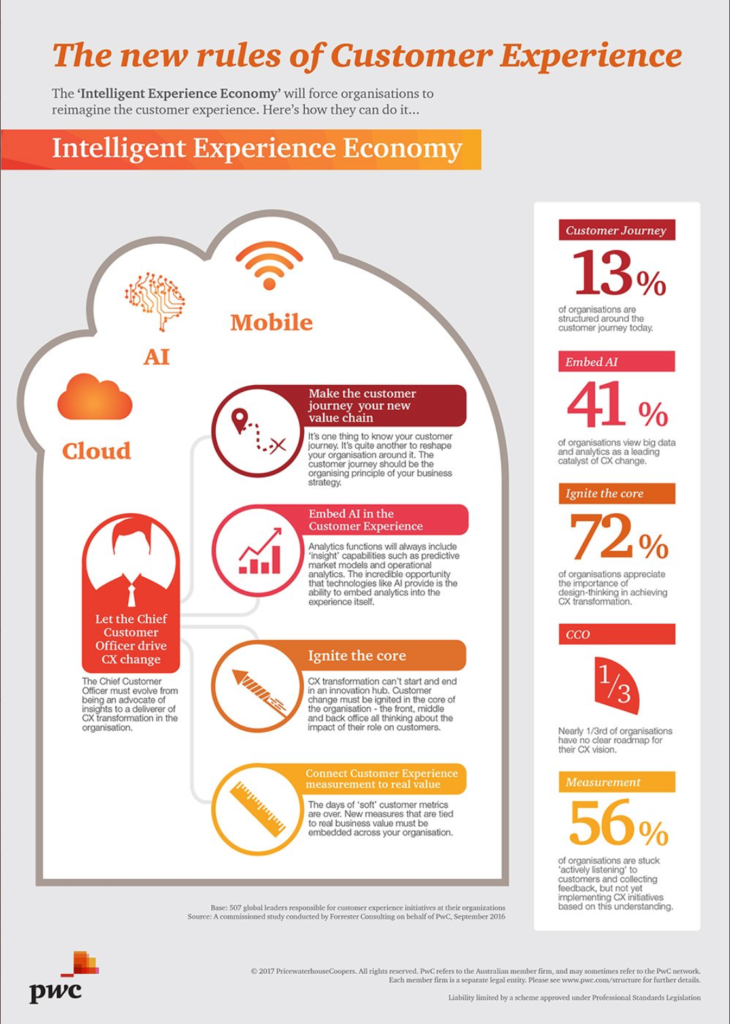You have undoubtedly seen customer experience strategy mentioned in multiple media outlets over the past couple of years. It seems like every marketing expert under the sun has weighed in on the topic in Forbes. Other news outlets like CMSwire have devoted well over a hundred articles about it from guest contributors. Digiday and Harvard Business review have written about it.
One aspect of customer experience I haven’t seen addressed, however, is how public relations can play a role in a customer experience strategy.
I personally believe that PR does play a major role. This post will give several ideas on how to ensure PR strategy can get in alignment with and further enhance a customer experience strategy.
So what exactly is customer experience?
Customer experience was defined rather succinctly by HotJar, a company I have come to admire for their website analytics and heat-mapping capabilities:
“Customer experience, also known as CX, is your customers’ holistic perception of their experience with your business or brand.”
In other words, it represents the sum total of a customer’s interactions with a brand during the customer journey. Customer experience can include any and all of the following customer touchpoints:
- Advertising or marketing campaigns
- Online or word-of-mouth referrals
- Youtube videos
- Interactions with sales people (in-person, on the phone or in a web chat)
- Packaging or online portal UX design
- Customer support
As you can see from the sample of customer touchpoints above, tracking customer experience is vast, diverse and challenging to document and monitor.
Is Customer Experience worth it?
Technology and the new-normal of social and streaming media is the primary driving force behind many brands embracing customer experience. For instance, it’s been reported that three quarters of customers expect a response within five minutes making contact online (McKinsey & Company).
Certain brands are clearly out in front and defining the new rules of the game. For example, Amazon and its Prime membership makes same-day purchasing and delivery a reality for millions of customers.

Indeed, as many as 80% of brands in a recent survey by Gartner plan to compete mainly on customer experience. A joint PWC and Forrester study in 2017 (see image at right) showed that only 13% of organizations were structured around the customer journey, which correlates highly with customer experience strategy.
Long before the customer experience movement was coined, successful companies have always excelled at more aspects of the customer experience than the competition. Apple was far better than many of its competitors when it came to designing computers that customers loved. From packaging, to product design to the actual product experience, Apple came to define customer experience in consumer tech. Lexus has always been a leader in customer satisfaction and product quality ahead of other luxury brands.
The rise of the Customer Experience ‘revolution’ has simply put a sharper eye on the need to be ROI-conscious when it comes to executing it across a multitude of customer touchpoints.
Which leads us to PR and how it can support those initiatives.
What role can PR play in customer experience?
News flash: Public relations already plays an important role in helping influence customer experience, across multiple channels. The fact is positive media coverage often shapes a customer’s perception of a brand before, during and after a purchase. Positive coverage coming from credible media outlets and respected influencers can give brands a favorable view in the eyes of customers.
On the other side of the coin is what customers feel when they experience other brand touchpoints. From a trade show floor to a customer support bot, customers have 100s of opportunities to have their experience influenced in positive, neutral and negative ways. The totality of experience can be daunting given how large it is, how much overlap there is, and how hard it is to accurately measure.
Knowing how important an integrated customer experience strategy is to helping propel growth and customer loyalty, brands have to figure out how public relations can reinforce its various initiatives.
PR isn’t a box to check off
Based on first-hand experience helping B2B technology companies with their communications strategy for product launches, trade shows and thought leadership campaigns, too often brands view PR as a box to check off from a list of marketing activities.
But make no mistake, communications professionals bring a unique perspective to a company and should not be treated like a separate and distinct silo cut off of mainstream corporate marketing. They have their fingers on the pulse of what journalists and influencers are saying about a brand, a trend or a given product. They are natural storytellers and can flex their own brand of journalistic muscles to influence the media and customers alike.
Lest you think PR is an antiquated process in today’s data-driven world, think twice. From free tools like Google Analytics to sophisticated ones enlisting AI and Big Data (think TrendKite), communications professionals can easily track, monitor, react to and report on the digital perception of a brand. (For more insight, see our previous article on how to measure PR using Google Analytics). In short, PR and its myriad activities are no longer a ‘black box’ executives can’t comprehend or justify. Thanks to data analytics, PR can plug directly into customer experience.
Swyft Customer Experience Example:
Not long ago Swyft had a discussion with a client about whether to announce a new product as a cloud platform or just call it an extension to an existing platform. Our inclination as PR professionals is to make the biggest announcement possible in order to maximize media buzz. During a planning discussion with their product marketing group and CMO, however, we soon realized that the company’s sales team and certain marketing assets regularly referenced the concept of a platform.
Unfortunately, there had never been an ‘official’ services platform launched with the usual and customary fanfare. The concern, therefore, was that officially announcing such a platform ‘late in the game’ might lead to customer confusion and even push-back in the media. In the end, we backed off the major platform announcement in favor of alignment with pre-existing communications.
If that isn’t integration of PR into the customer experience equation then I don’t know what is.
Lack of actionable case studies
At Swyft we frequently see opportunities for incredible case study material that can be turned into a powerful customer-facing narrative shared with the media. Case studies and customer success stories can drive positive media coverage and shape customer perception about a brand by providing highly relatable examples, facts and quotes.
You would be surprised at how many brands have great customer stories to share in a variety of formats and mediums but can’t turn them into outward facing content because the customer never agreed to it.
Missed opportunities like these happen for a variety of reasons. One is that if you are a smaller company and your customer is a large enterprise, the customer may categorically refuse to allow any outward-facing marketing content. Another reason is that companies simply fail to ask for a case study. Hard to believe, isn’t it?
To avoid this, the marketing team should work with its sales and legal teams to ensure a brand can leverage the relationship to get a chance to share positive results with the media. Some brands accomplish this by adding additional services or features to sweeten the deal.
Once armed with a collection of case studies, the communications team can leverage them in a variety of media outreach campaigns with the goal of shaping a positive customer experience narrative.
Stop the damage
Customer experience is often impacted by negative reports based on events or even hearsay. Given that technology gives customers a way to amplify their opinions rapidly and at scale, it’s imperative that brands monitor any negative sentiment in the marketplace. Where there is a risk of a particular complaint or media report catching fire, then PR can help recast the negative narrative in a way that is consistent with a company’s customer experience strategy.
That doesn’t mean PR should be the only team involved in addressing a negative narrative. By working across marketing channels and departments, the entire company can formulate a response strategy. From owned and earned media to social posts and influencers, a company should enlist a broad array of communications to alter the news trajectory. Customer service and sales often need to be brought into the loop to allay potential concerns from customers and prospects.
At the end of the day, the goal is for communications to acknowledge and realign the narrative in the media as best as possible. By offering countervailing owned and earned content, a brand can sway more opinions in its favor. Better that than sitting idly by as the storm surge washes over them.
Conclusion
For customer experience to become a basis for a brand’s competitive strategy, it has to be seamlessly applied across all relevant functions and departments. If a human or digital function or process has any kind of potential customer impact, it has to be factored into customer experience. Even the sound of a voice on a company’s voicemail has an impact.
More and more, communications professionals utilize a mix of both earned and owned and even paid media. Translation: communications professionals have more potential to influence customer experience than ever before.
Not surprisingly, smart brands have always been wise to how to manage their brand perception in the media. They will also be leaders in bringing PR in alignment with customer experience to cement their continued dominance in their respective industry verticals.

